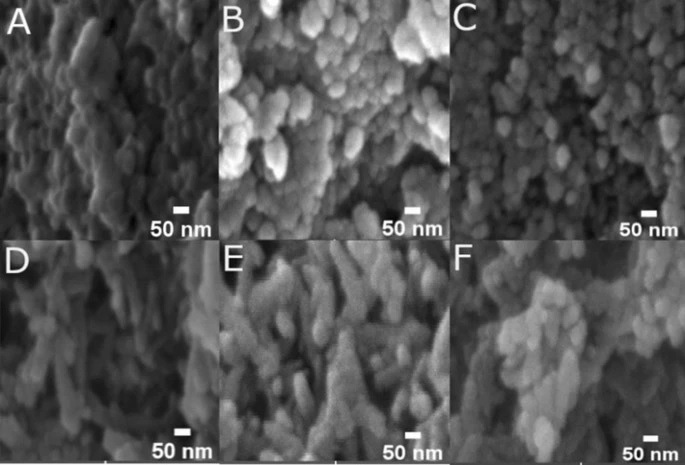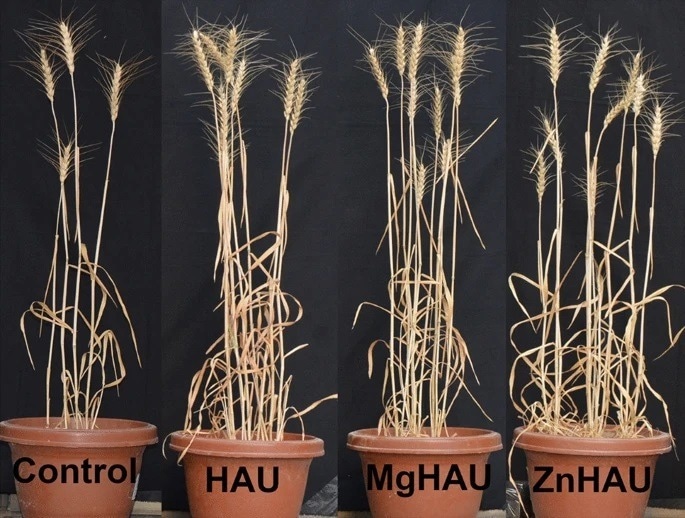The unrestricted use of synthetic fertilizers in agricultural fields is largely responsible for global warming and biodiversity degradation. Therefore, the agriculture industry requires rapid technological advancement to sustain high crop yields.

Study: Zinc- and magnesium-doped hydroxyapatite-urea nanohybrids enhance wheat growth and nitrogen uptake. Image Credit: Tanya Kalian/Shutterstock.com
A recent study published in the journal Scientific Reports focuses on this issue by reporting the production of zinc- and magnesium-doped hydroxyapatite-urea nanohybrids. These nanohybrids can be employed as a novel source of nitrogen and are comparable with typically used urea-based fertilizers for the effective delivery of nitrogen to wheat plants.

Figure 1. Powder X-ray diffraction (PXRD) analysis of the synthesized nanohybrids (HAU, MgHAU, and ZnHAU), bare nanoparticles (HAP, MgHAP, and ZnHAP), and urea.
Synthetic Fertilizers: Overview and Environmental Threats
Human civilization is facing an existential crisis as the current agricultural output will soon not be enough to fulfill the global food requirements. According to current estimates, a 119% rise in agricultural output would be necessary to sustain the world's growing population.
Over the past five decades, the usage of fertilizers in agriculture has expanded rapidly in tandem with population growth to reach the necessary agricultural output. Chemical fertilizers are widely sprayed on farming fields to maintain crop output, but their broad usage has major environmental consequences.
The use of synthetic fertilizers is expected to increase agricultural output across shorter periods. However, crops only use 15 - 30% of the fertilizer supplied, and the remainder pollutes water sources and soil. For instance, chemically manufactured fertilizers include acid leftovers like hydrochloric acid and sulfuric acid. These acids disintegrate soil particles and harm soil health.
Using chemical fertilizers modifies the soil's nutritional content, lowers rainwater penetration into the soil by modifying porosity, causes insect infestations, and decreases the soil's water-holding capability, resulting in the elimination of beneficial microbes.

Figure 2. Scanning electron microscopy (SEM) images of the synthesized nanoparticles. (A) Hydroxyapatite (HAP), (B) Magnesium doped hydroxyapatite (MgHAP), (C) Zinc doped hydroxyapatite (ZnHAP), (D) Hydroxyapatite-urea (HAU), (E) Magnesium doped hydroxyapatite-urea (MgHAU), and (F) Zinc doped hydroxyapatite-urea (ZnHAU).
Nanomaterials for Enhancing Nitrogen Uptake in Crops
Nitrogen is an essential ingredient of chemical fertilizers because it is an important nutrient for many plants, including wheat and rice. However, nitrogen discharge in the soil is a major issue for the agricultural industry. Crop yields and nitrogen absorption may be considerably increased by minimizing nitrogen discharge from agricultural areas by controlled nutrient distribution to plants using nanomaterial integration.
Various nanomaterials have been used as growth accelerators to give plants vital nutrients like nitrogen. However, the physical or chemical properties of nanoparticles restrict their environmental and agricultural applications.
Although heavy metals and carbon-based materials demonstrate exceptional and versatile electrical, photonic, and structural capabilities, their usage in agricultural applications should be avoided due to their negative environmental implications. As a result, nanomaterial composition and fabrication must be extremely carefully addressed for large-scale agricultural usage.
Nano-Fertilizers: The Future of the Agricultural Sector
Nano-fertilizers are a subgroup of nanoparticles with distinguishing characteristics such as surface charge, large surface area, and various morphologies. These features may be used to combine nutrients with nanomaterials for targeted delivery and sustained nutrient uptake in the soil, reducing the need for synthetic fertilizers and providing accurate nutrient administration to plants.
Nanoscale particles have a larger surface area, compact structure, and more flexible surface composition, allowing seamless manufacturing and engineering for building efficient nutrition delivery systems.
Hydroxyapatite is a naturally accessible, biodegradable, nutrient-rich, highly reactive substance that can be tailored to supply nitrogen fertilizers to essential crops such as wheat and rice. The hydroxyapatite-based nano fertilizers deliver nitrogen gradually and remain in the soil for a longer period, minimizing synthetic nitrogen additions to the soil.
Highlights and Key Developments of the Study
In this study, multi-nutrient compounds, including urea-coated hydroxyapatite nanohybrids, urea-coated zinc-doped hydroxyapatite nanohybrids, and urea-coated magnesium-doped hydroxyapatite nanohybrids were produced, characterized, and employed as nitrogen nano-fertilizers for wheat plants.
Moreover, nitrogen release, nanohybrid properties, and nitrogen administration were studied throughout the wheat reproductive cycle.
Doping with zinc and magnesium changed the crystalline nature of hydroxyapatite, resulting in a smaller size and increased nitrogen loading capability. Remarkably, 50% and 25% urea nanohybrid dosages considerably increased wheat growth and yield compared to 100% urea fertilizer doses. Additionally, nutritional element absorption as well as grain protein and phospholipid concentrations, were dramatically increased in wheat sprayed with nanohybrids.
These findings show that the as-prepared multi-nutrient compounds can potentially be nitrogen distribution agents that decrease nitrogen inputs by at least 50% while preserving wheat plant development and nitrogen uptake at levels comparable to full-dose urea treatments.

Figure 3. Wheat plants (at maturity) treated with nitrogen fertilizers, left to right: Control (Urea Fertilizer-100% RDNPK), HAU (Hydroxyapatite-Urea 50% Suspension-50% RDN + 100% RDPK), MgHAU (Mg doped-Hydroxyapatite-Urea 50% Suspension-50% RDN + 100% RDPK), and ZnHAU (Zn doped-Hydroxyapatite-Urea 50% Suspension-50% RDN + 100% RDPK) in a pot experiment setup.
Reference
Sharma, B. et al., (2022). Zinc- and magnesium-doped hydroxyapatite-urea nanohybrids enhance wheat growth and nitrogen uptake. Scientific Reports volume. Available at: https://doi.org/10.1038/s41598-022-20772-w
Disclaimer: The views expressed here are those of the author expressed in their private capacity and do not necessarily represent the views of AZoM.com Limited T/A AZoNetwork the owner and operator of this website. This disclaimer forms part of the Terms and conditions of use of this website.